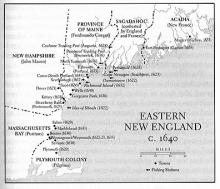Maine's First Maritime Settlers

Maine’s earliest coastal towns were established by English ProprietorsProprietors
Those to whom the British king granted exclusive control over a colony. This allowed the king to indirectly control the colony without investing. Sir Ferdinando Gorges became one of the proprietors of the Province of Maine in 1622, splitting it at the Piscataqua River in 1629. : Pemaquid (late 1620s); York, Cape Porpoise, and Saco (1630); Kittery (1631); Scarborough (1632); Falmouth (1633); North Yarmouth (1636); and Wells (1642).
Early settlers in Maine and Massachusetts were different. Maine settlers wanted to gain access to land and fisheries to better their lives, while Massachusetts PuritansPuritans
Members of the English Anglican Church who wanted to reform or purify the church, advocating strict religious discipline and simplification of the ceremonies of the Church of England. In America the term is used to refer to the immigrants led by John Winthrop who arrived in 1630. were motivated by religion. Dissenters from Puritan ideology often fled to Maine, in search of religious tolerance. In 1729, a number of self-reliant Scotch-IrishBorderlanders Scotch-Irish
Scottish families living in Northern Ireland. Also called Scotch-Irish. Many Maine settlers were from this group of people, who were known for their toughness and ability to live on the frontier. settlers moved to the midcoast. These Borderlanders valued independence above all, and were suspicious of outside authority. The Scotch-Irish had a lasting cultural impact. They settled Boothbay, Damariscotta, and Newcastle. Many of the older Maine coastal families trace their lineage to the first Scotch-Irish settlers. Later, more Scotch-Irish and German settlers were recruited. Waldoboro was settled by German immigrants.

